fiscal federalism
1/56
There's no tags or description
Looks like no tags are added yet.
Name | Mastery | Learn | Test | Matching | Spaced |
|---|
No study sessions yet.
57 Terms
fiscal federalism
addresses the division of revenue collection and expenditure between levels of government
which levels of gov should spending and revenue decisions be made at
these concepts also apply to allocation within an economic union
typical levels of government
– Central (or federal)
– State or Devolved Nations in UK
– Town councils
– Parish councils
taxation across different levels of government
each level employs taxes
Central government faces no restrictions on the choice of
taxes
Local governments face restrictions imposed by central
government
expenditure across different levels of government
Central government usually takes responsibility for
defence, law and order, and transfers
Lower levels responsible for education, health care, and
refuge collection
subsidiarity
is a principle in fiscal federalism that dictates decisions should be made at the lowest possible level of government, ensuring efficiency and responsiveness to local needs.
fiscal federalism in the European Union
Closer economic integration raises issues about
subsidiarity (which is the freedom of individual
member states to choose policy)
Fiscal federalism guides the design of the
institutional structure for an economic union
arguments for multi level government
justified if it raises efficiency or enhances equity when compared to
single-level government
can increase amount of info
tiebout model
People will move to communities that provide the mix of taxes and public services that best matches their preferences. Over time, this leads to an efficient allocation of resources across jurisdictions and promotes competition among local governments.
e.g if u want higher spending u accept higher taxes
consumers reveal preferences through their choice of community
theres no impediments to movement so efficiency is ensured
Why does the market do so well for private
goods but not public goods?
no shopping and competition if we have a centralsied government thay deicdes everyhting people cant shop around and compete
what happens when public goods are provided at the local level
by cities and towns
competition arises because individuals can vote with their feet.
if you dont like the tax and spending bundle in the jusrdsiiton in which youre living, you can move to another one
maybe you think the things provided are fine but provided inefficnietly, so you move and this forces them to become more efficient
This threat of exit can induce efficiency in local public
goods production
why is competition good across towns
People move freely across towns, picking their
preferred locality.
• People with similar tastes end up together, paying
the same amount in taxes and receiving the same
public goods.
• There is no free riding because everyone pays the
same amount in each town
major benefits of tie bout model
its the main benefit off decentrlisaon
taste matching: people with similar benefits will be together
people are at higher level of utility, can vote with ur feet
more efficient outcomes, government competiton kind of mimics market competition
tiebout diagram
Assume two groups of consumers A and B and a single public good financed by a uniform income tax
G = public good provision
publci provison is likely to be a copromise, so somewhere like g0 where a and b have to compropmise
Group B have a stronger preference for the public good than group A
In the figure the optimal public good levels are GA and GB
The uniform level G0 involves a utility loss for both groups
if you break it up into jurisdictions, you can let everyne who belived A live and be giverned by 1 thing and B in another, whih ismore efficent
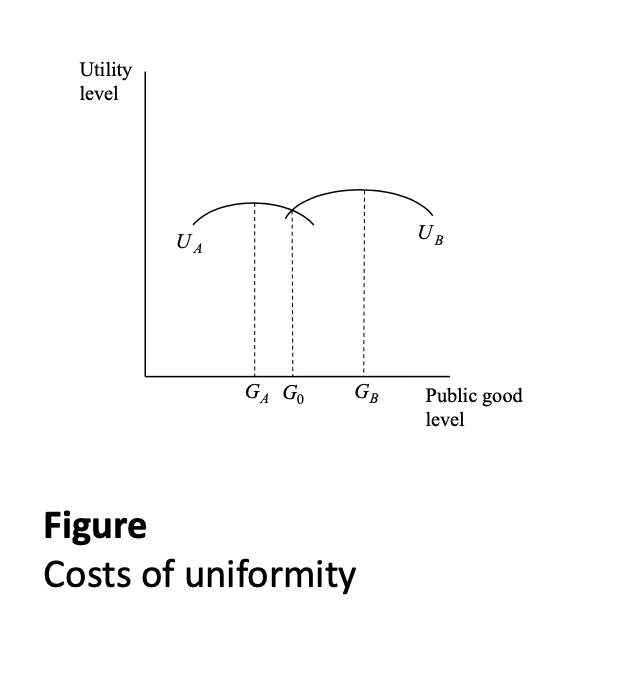
assumptions of the tie bout model
People are actually able to move
not everyone can free pf charge
People have full information on taxes and benefits
most people dont know or understand them
People must be able to choose among a range of towns that might match my taste for public goods.
is there variety or enough variety
The provision of some public goods requires sufficient scale or size.
assume scale ecoomies dont really exist, but this is a big problem
There must be enough towns so that individuals can sort
themselves into groups with similar preferences for public goods.
problems with tiebout model
its assumptions make it extremely unrealistic and so it doesnt work irl
gooods we’d be concerned about leaving this model:
spillovers/externalities
education, policing, environmental projects etc - if one area spends more on education/policing, theres an externality effect bc free riding can happen e.g one place might not spend mihc on it and then just hire peope from a state tjaty does spend lots on it
second issue is financing: under tiebout you get what youb pay for regardless of incmoe, which ignores equity issues. if you want nore spent on educstion e.g, you go to another place that spends more on it
but this isnt very equitable. e.g if you tax the rich high and poor low, the rich can just leave to other places that have lower taxes and you might end up attracting all the low income people
to avoid this ioncome taxes etc are done by central government
average costs can come down with centralised decisions e.g national defence
financing problems with the tiebout model
The Tiebout model requires equal financing of the
public good among all residents, requires a lump sum tax
• Lump sum taxes are often infeasible/unfair, so
taxes are income or wealth based.
• But then the rich pay more than the poor, so the
poor chase the rich, may 3ant to come into rich communities and free ride
lump sum tax
A fixed taxation amount
independent of a person’s income, consumption
of goods and services, or wealth.
no redistributiin with lump sum taxes so if youre poor and you really like the goods, if you cant afford the lump sum tax then the rich will all gather in one community and the poor in another - so itll end up being communties based off income not tastes
externality problems with the tiebout model
The Tiebout model assumes that public goods
have effects only in a given town and that the
effects do not spill over to neighboring towns.
• Many local public goods have similar externality
or spillover features: police, public works,
education.
• If there are spillovers, then low-tax, low-benefit
municipalities can free-ride off of high-tax, high-
benefit ones.
if theres spillovers the low spending community can be free riding off the high spending community which means its underoprovided and the high spending might try and free ride back which creates prorblems
summary of tiebout model
Tiebout model implies that three factors determine local
public good provision:
1. Tax-benefit linkages: The relationship between the taxes
people pay and the government goods and services they
get in return (so redistribution of income at federal level)
2. Cross-municipality spillovers in public goods.
3. Economy of scale in public good provision.
• If taxes and benefits are linked, and there are no spillovers or
economies of scale, then local public good provision is close
to optimal.
its better than federal even if people arent well infomred
local communties can respond better to what they want cmpared to central govenremnts
what does the tiebout argument ignore
the scale of government and the costs of having multiple layers
Each public good has a level of government at which it
is best delivered
Defence is best delivered nationally
Trash collection is best organized locally
If there were no costs it would be optimal to have the number of levels of government matching the requirements of the public good
but irl theres costs like staff, building, equipment etc
optimal government structure
trades the costs against the benefits
the more local you go the better the prpvisoon is but theres costs to going this local
Public good provision can be centralised or decentralised
optimal structure drawn
A federation is represented
by the line segment [0, 1]
0 = not interested at all, 1 = very interested
The population is uniformly
distributed
• Centralized provision
locates the public good at ½ (where median voter is)
• Region L is the interval [0,
½] and region R the interval
[½, 1]
• Decentralisation locates the
public good at ¼ and ¾
2 median voters, one in both sections, then we see whats chosen here
![<ul><li><p>A federation is represented</p></li></ul><ul><li><p>by the line segment [0, 1]</p><ul><li><p>0 = not interested at all, 1 = very interested </p></li></ul></li><li><p>The population is uniformly</p><p>distributed</p><p>• Centralized provision</p><p>locates the public good at ½ (where median voter is)</p><p>• Region L is the interval [0,</p><p>½] and region R the interval</p><p>[½, 1]</p><p>• Decentralisation locates the</p><p>public good at ¼ and ¾ </p><ul><li><p>2 median voters, one in both sections, then we see whats chosen here</p></li></ul></li></ul><p></p>](https://knowt-user-attachments.s3.amazonaws.com/07578429-cca0-40f5-bed7-5c4c2f17c773.png)
costs of public good with and without centralisation
The cost of the public good is C per person with
centralisation and 2C with decentralisation
utility wiyh centralisation equation
alpha tells us how much u care about the issue
if alpha was 1 and i was 1/2, utulity is 1-c which is the max level you can get, best outcome
the further you get away from 1/2 the worse off you will be
With centralisation the average distance is 1/4
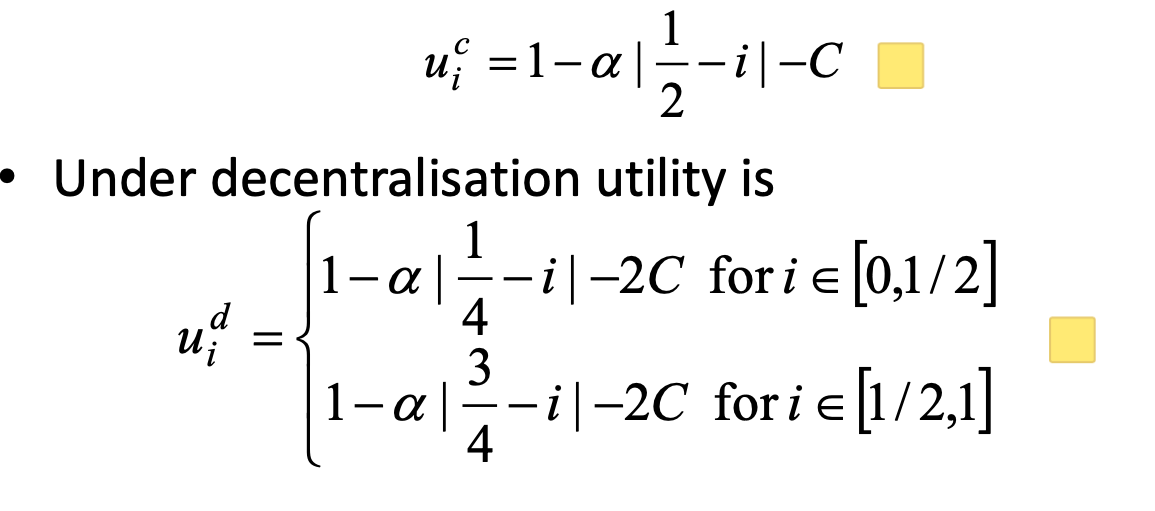
utility with decentralisation
change the 1/2 from above to 1/4 and 3/4, so ideals would be when i is 1/4 and 3/4 respectivly
Decentralisation is chosen if it leads to higher total
utility than centralisation
With decentralisation the average distance is 1/8
Hence decentralisation is optimal if
1 −α[1/8]-2C > 1 −α[1/4]-C
C ≤ α[1/4 - 1/8]
hold when c ≤ α/8
if costs less than alpha/8, and alpha is how much u care about matching ur preferences, then you’ll do it
![<ul><li><p>change the 1/2 from above to 1/4 and 3/4, so ideals would be when i is 1/4 and 3/4 respectivly</p></li></ul><ul><li><p>Decentralisation is chosen if it leads to higher total</p><p>utility than centralisation</p></li><li><p>With decentralisation the average distance is 1/8</p><ul><li><p>Hence decentralisation is optimal if</p><p>1 −α[1/8]-2C > 1 −α[1/4]-C</p><p>C ≤ α[1/4 - 1/8]</p></li><li><p>hold when c ≤ <em>α</em>/8</p></li><li><p>if costs less than alpha/8, and alpha is how much u care about matching ur preferences, then you’ll do it</p></li></ul></li></ul><p></p>](https://knowt-user-attachments.s3.amazonaws.com/3807e0eb-876c-475e-ab39-2c764e45c5c4.png)
how you might end up with excessive decentralisation
the averahe citizen will either be 1/4 or 18, away, but the median voter will be at 1/4, so clearly im more infavour of decentralisation than the average citizen
so i’d allow decentralsaition to go through at higher cost
median voter theorem: if u assume theres some parties competing to set a policy, and if all our policies are set from 0-1/2, then the policy thats chosen wil be 1/4
this captuires tiebout, problem with scale economics and politics
choice between centralisation and decentralisation by voting
The Median Voter Theorem makes the central voter in each region decisive
• Decentralisation will win a vote against centralisation if: photo
voting can lead to excessive decdentrlisaiton

economic argument for politics
Govs have to produce policies efficiently or we will kick them out for someone else
if we knew exactly if the government was behaving at its very best and be able to kick them out if they werent, it would be fine but we cant
when is a government accountable
if voters can Discern the behavior of the government
Sanction the government if it is not acting correctly
Accountability ensures incumbents will be brought to account for past actions
The need to seek re-election produces a trade- off between diverting rents and losing office
agency problem
voters have no real reaosn to be well infomred because you cant decide whose going to win solely, you shouldnt expect to be pivotal
this leads to an agency prpbkem - governmetn is the agent and the voter is the badly informed principal
voters may be Poorly informed about politician type, Observe politician behavior imperfectly, and lectoral sanction is a blunt instrument bc politicans might be able to get away with things, be corrupt and still get re elected
how’s can decentralisation assist with the control of politicians
Breaks the monopoly of a single government
Allows comparison of performance across jurisdictions
arguemnt here is i might not really know if ur good or not and if youd work in my interest, but i can see whats hapopening in other jurisdictions and what works well there
i can learn from other soruces which can inform me aboit whats happening here
Circumstances are good in state a, but bad in state b
• Policy A (B) is best for citizens in state a (b)
• The ranking is reversed for the government
• V is the value of re-election and r the rent from choosing incorrect policy
• The government knows the state, citizens observe only
their welfare level
we dont know if theyre doing policy a or polocy b
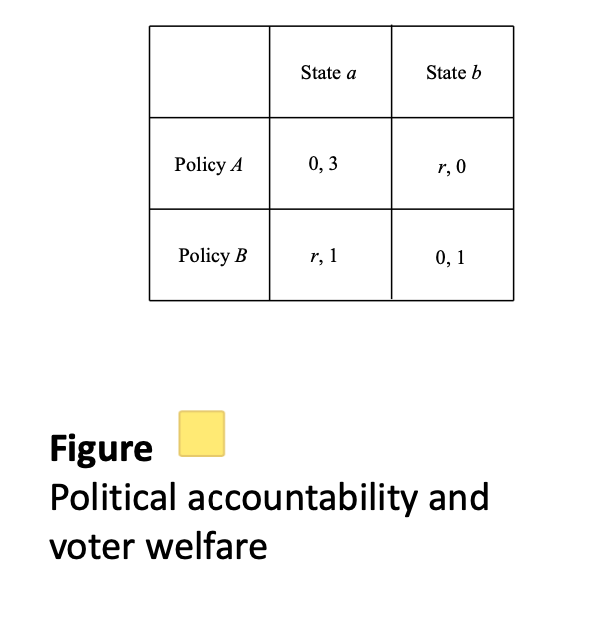
how does decentralisaiton help with solving the problem that no matter what voting you have theres incenitive for rent seeking from the government
- theres competition, so if a voter sees other states. have it better then when they go to vote, theyll vote for someone else. if politicanas antiticpte this, they dont rent seek because they want to be re elected
big bonsu of decentralsied governments: experiments
e.g in us theres 50 states and when something succeeds, it can spread across all states
why would we not want full decentralisaiton and risk sahring?
some states just wouldnt help each other out, wouldnt bail out so union can be lost
if u centralise it wont people know that the taxes they pay helpo other states anyway? yes but its not as explicit, builds a semse of amntional identitiy
interregional insurance
shares risks between regions
Interregional insurance is organized through federal taxes and transfers
this is how it works in the us
when is mutual inseuancwe possible
if theres some independence of risk, so some regions suffer losses but others dont
independence is unlikely for regions, and with an asymmetric distribution of risk (there are
regions which suffer adverse shocks more frequently)
some regions will typically subsidize others
– This is redistribution not insurance
risk sharing with regions
Two regions a, b and two
states a, b
• Probability 1/2 of a gain
• Total income constant at Y =
ya + yb +
• Optimal risk-sharing is to
transfer t* = /2 from region
that gains
• Regional incomes are constant after the transfer

what choice does a region that gains from risk sharing face
a choice between:
Making the transfer and enjoying future insurance
Keeping the gain and losing future insurance
The choice made is dependent on the discount rate
• When future payoffs are highly discounted only
partial insurance is possible
should we are about inequalities across municipalities
If Tiebout is right, then this reflects optimal sorting and
financing.
– But if not, redistribution might be called for.
– The main tool of redistribution is intergovernmental grants,
cash transfers from one level of government to another.
different forms of grants
Block grant: A grant of some amount with no
mandate as to how it is spent. (like this in the UK)
Conditional block grant: A grant of some amount
with a mandate as to how it is spent.
Matching grant: A grant, the amount of which is
tied to the amount of spending by the local
community.
matching grant diagram
• Matching grant: A grant, the amount of which is
tied to the amount of spending by the local
community.
a lumo sumo transfer may be better
use matching grants with education as it has positive externalities
a matchng grant makes esne bc theres already a dsitoriton, so its ok to intorduce another.
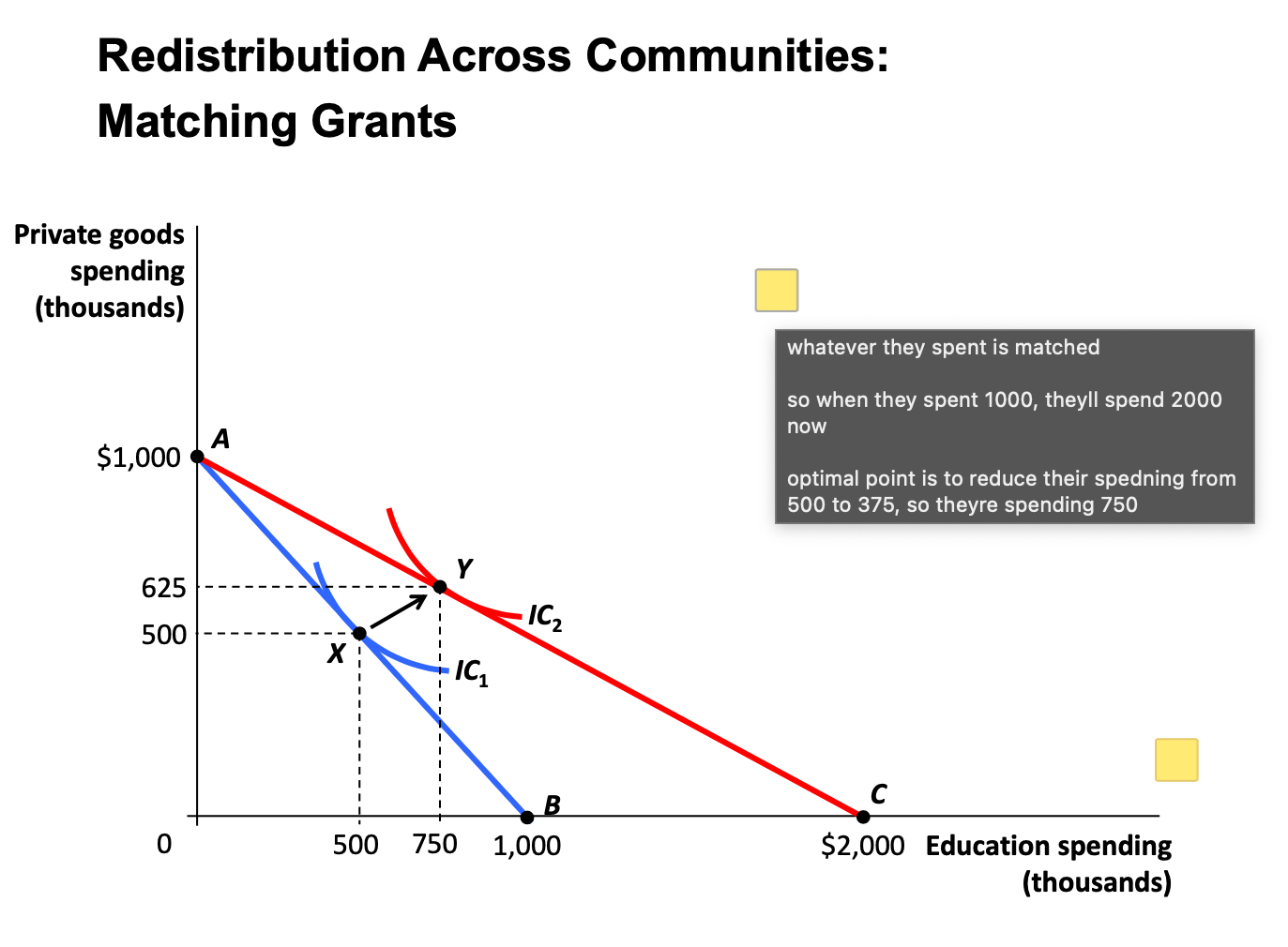
block grant diagram
they couldve given them 375, which would be better bc indivduals dont face dsitortionary effect on budget constraint and it would purely be an incme effect
theyre not commiteed to having to spend 375 on education, and actually only spend 75 so they can put the rest of the 300 int tax cuts which can now be 800
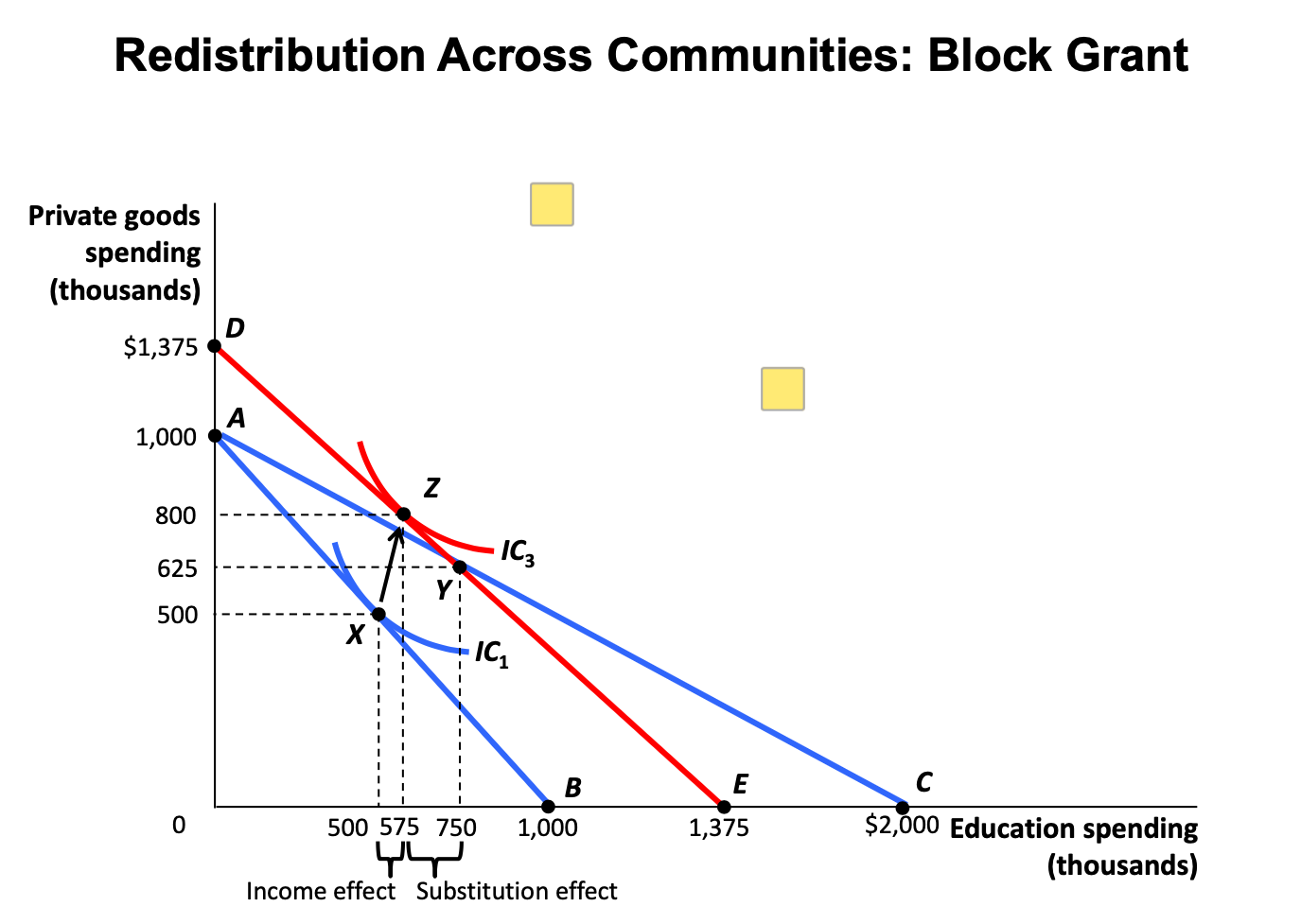
matching grant vs block grant
Welfare is higher with block grants
• But if there are positive externalities, a
matching grant internalises these and thus is
better for welfare.
• If externalities are large, perhaps spending
decision should be centralised.
• Use block grants for redistribution, but block grant could be made equivalent
by a cut in taxation
the flypaper effect
money sticks where it hits, even tho in theory block grant saysd it should be sahred between tax cuts and public spending, in reality poublci spending gets most of it
hard budget constraint
A hard budget constraint must be met which
requires a credible commitment from the centre
soft budget constraint
A soft budget constraint can be manipulated by the
local government
• Soft budget constraints lead to inefficiency because
they encourage strategic behavior
leads to moral hazard
Local governments may borrow excessively knowing
they will receive a bailout
how can fiscal decentralisation be measured
Share of total revenue collected by centre
– Share of centre in all public expenditure
– Share of centre in consumption expenditure
Share of total revenue collected by centre
fails to account for levels from differnt regions, doesnt hlpe with decerntralisation
Share of centre in all public expenditure
inlcudes redsitributin, which is almost always an activity of the centre and so exaggerates the level
Share of centre in consumption expenditure
this is the best
measure of decentralisation
data on decentralisation
developed countries are
more decentralised
Latin American countries
decentralized between 1980
and 1985
African countries are the
most centralized
World level shows a trend
of decentralisation
political aspects of decenraliasiton
Larger and richer countries decentralise more
• Urbanisation increases decentralisation
• Decentralisation increases with the level of
democracy and ethnolinguistic fractionalization
• The threat of secession is also a force for
decentralisation